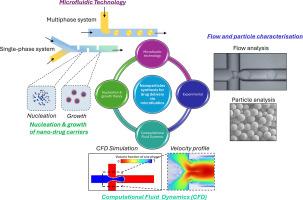CFD approaches in microfluidics for the development of polymeric, lipid-based and inorganic nanoparticles for drug delivery
IF 7.1
Q1 ENGINEERING, CHEMICAL
引用次数: 0
Abstract
Microfluidics is an innovative approach for manufacturing nanoparticles in a precise and controllable manner. However, the experimental optimization of microfluidic nanoparticle fabrication faces challenges related to the intricate interplay of various process parameters within the microscale environment. The integration of experiments and computational fluid dynamics (CFD) offers a synergistic approach that allows the researchers to validate and optimize theoretical models with real-world experimental models, enhancing the precision of nanoparticle synthesis and facilitating the design of more efficient microfluidic systems. This review provides a critical analysis of the current state of knowledge on recent advances of numerical investigations for nanoparticle synthesis using microfluidic-based methods. In particular, an overview of CFD assisted studies for microfluidic production of nanoparticles is presented, whilst their advantages and limitations are discussed. The importance of numerical modelling using CFD on the understanding of droplet generation, mixing and reaction mechanisms and how these phenomena are associated with nanoparticle nucleation and growth are highlighted. Different microfluidic-based approaches to produce uniform nanoparticles are presented and the most promising techniques are identified and discussed in detail. Both passive and active mixing microfluidic strategies are considered, highlighting their impact on nanoparticle formation. A comparative study of experimental and numerical approaches is performed to provide a better understanding of the droplet breakup mechanisms and the influence of physicochemical parameters on the size and shape of the produced nanoparticles. The review confirms that adoption of CFD simulations can be beneficial to identify critical flow conditions and reaction zones, which are essential for controlling the synthesis of nanoparticles. Finally, by systematically integrating CFD with experimentation, it will be possible to translate microfluidic nanoparticle synthesis into scalable and industrially viable technologies.

微流体中的CFD方法用于开发用于药物输送的聚合物、脂基和无机纳米颗粒
微流体技术是一种以精确和可控的方式制造纳米颗粒的创新方法。然而,微流控纳米颗粒制备的实验优化面临着微尺度环境中各种工艺参数复杂相互作用的挑战。实验和计算流体动力学(CFD)的整合提供了一种协同的方法,使研究人员能够用现实世界的实验模型验证和优化理论模型,提高纳米颗粒合成的精度,促进更高效的微流体系统的设计。这篇综述提供了一个批判性的分析,目前的知识状态,最近的进展,数值研究的纳米颗粒合成使用微流体为基础的方法。特别是,概述了CFD辅助研究的微流体生产纳米颗粒,同时讨论了它们的优点和局限性。强调了利用CFD进行数值模拟对于理解液滴产生、混合和反应机制的重要性,以及这些现象如何与纳米颗粒成核和生长相关联。提出了不同的基于微流体的方法来生产均匀的纳米颗粒,并确定了最有前途的技术,并详细讨论了这些技术。考虑了被动和主动混合微流控策略,突出了它们对纳米颗粒形成的影响。为了更好地理解液滴破碎机制以及物理化学参数对纳米颗粒大小和形状的影响,进行了实验和数值方法的比较研究。该综述证实,采用CFD模拟有助于确定临界流动条件和反应区域,这对控制纳米颗粒的合成至关重要。最后,通过系统地将CFD与实验相结合,将有可能将微流体纳米颗粒合成转化为可扩展和工业上可行的技术。
本文章由计算机程序翻译,如有差异,请以英文原文为准。
求助全文
约1分钟内获得全文
求助全文
来源期刊

Chemical Engineering Journal Advances
Engineering-Industrial and Manufacturing Engineering
CiteScore
8.30
自引率
0.00%
发文量
213
审稿时长
26 days
 求助内容:
求助内容: 应助结果提醒方式:
应助结果提醒方式:


